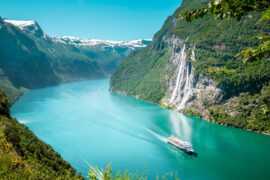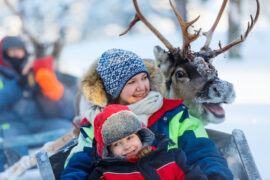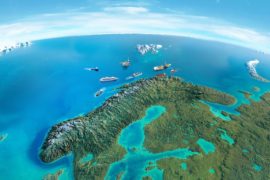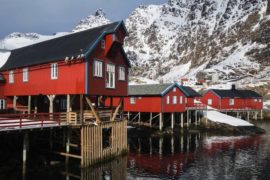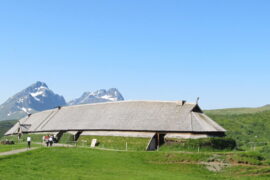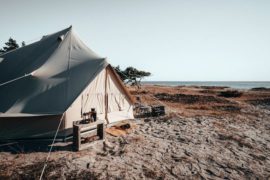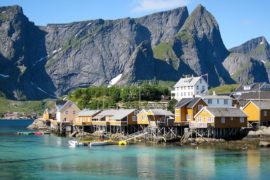We’ve all heard of the Arctic Circle, but do you know what is it? Is it a real circle? And if so, where is it on the map?

We’ve done some research and come up with some fascinating facts about the Arctic Circle, and answered some of your most pressing questions about it.
So read our ultimate guide to find out all you need to know about this imaginary geographical line.
What is the Arctic Circle?
The Arctic Circle is a line of latitude that, in geographic terms, separates the Arctic Zone in the north from the Northern Temperate Zone below it.
Put simply, it’s an imaginary line above which the sun never completely sets on the summer solstice (June 21st) and never completely rises on the winter solstice (December 22nd).
So, that means anywhere north of the Arctic Circle has 24 hours of daylight in mid-summer (known as the midnight sun) and 24 hours of darkness in mid-winter (also known as the polar night).
What is the latitude of the Arctic Circle?
The Arctic Circle’s coordinates are approximately 66°33′45.6 north of the Equator. We say approximately because its position varies depending on the tilt of the Earth on its axis.
The Arctic Circle is also being nudged – admittedly very slowly – by the Moon’s gravitational pull, and is currently heading north at a rate of about 14.5 metres a year.
What degree is the Arctic Circle?
Its generally quoted location is 66.6° N, but as we’ve seen above this is not an exact measurement.
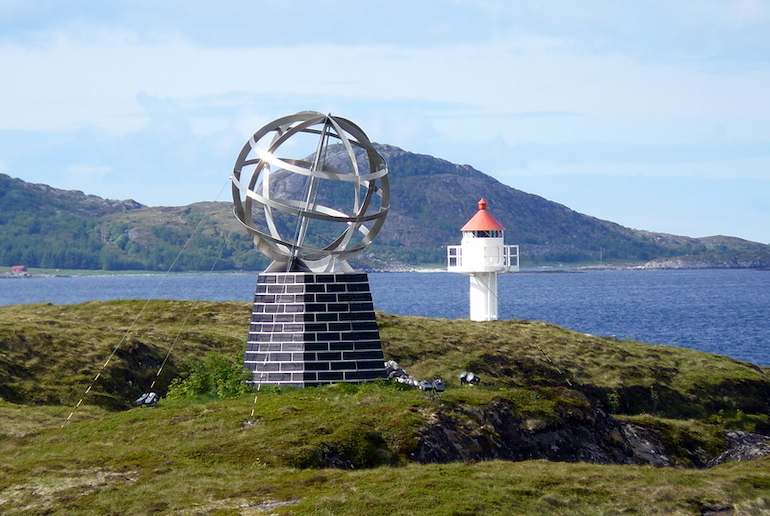
However, it’s easier to remember than the exact measurement so has been recognised by popular culture as the mark of the Arctic Circle.
So much so that the cult Icelandic clothing brand 66°North adopted the name!
Is the Arctic Circle north or south?
The Arctic Circle is the most northerly of the five major circles of latitude that run around the Earth.
The Arctic Circle and the Antarctic Circle are the most northerly and southerly circles of latitude, with the Tropic of Cancer in the northern hemisphere, the Tropic of Capricorn in the southern hemisphere and the Equator in the middle running right around the centre of the Earth.
What’s the difference between the Arctic Circle and the Arctic?
So, where is the Arctic then? Well, most scientists define the Arctic as the area that lies above the northern polar circle.
However, some geographers consider the Arctic as a geographical region where the average temperature in the warmest month of the year is below 10ºC.
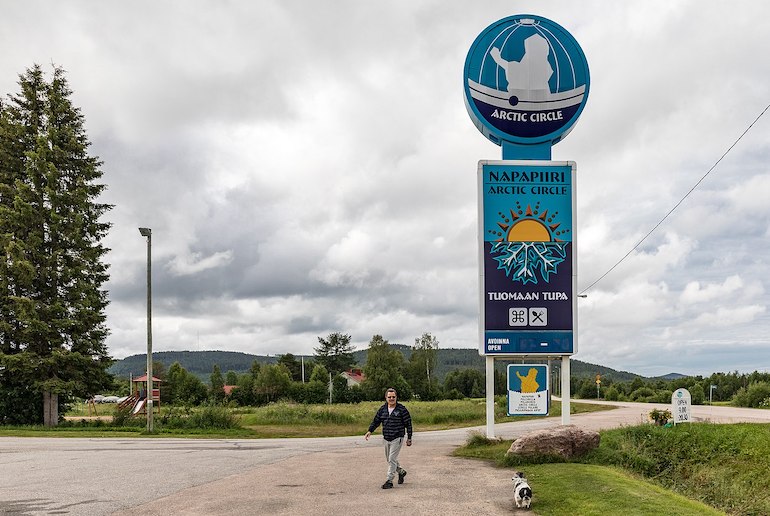
But what everyone agrees about is that the Arctic Circle is an imaginary line about 9,900 miles long, and the Arctic is a region that covers a whopping 5.5 million square miles.
Is the North Pole in the Arctic Circle?
Yes, the geographic North Pole is the northernmost point of the Arctic region, and lies pretty much at the central point of the northern polar circle. And the distance from the Arctic Circle to the North Pole is around 1600 miles.
So, if you thought that the Arctic Circle was pretty far north, the North Pole is a long way further north still!
The difference between the Arctic Circle and the North Pole is that the Arctic Circle is an abstract line of latitude, while the North Pole is a fixed point.
Well, not really fixed because, like the Arctic Circle, the North Pole also moves slowly due to the pull of the Earth’s magnetic core.
Is the Arctic a country?
No, the Arctic a region which covers the northernmost part of the ‘Arctic Circle countries’.

There are eight countries that have land within the northern polar circle, and these are Canada, Greenland (an autonomous country within the realm of Denmark), Iceland, Norway, Sweden, Finland, Russia and the USA (specifically, Alaska).
How cold is the Arctic Circle?
Since the area within the the northern polar circle is so huge, it’s not surprising that temperatures vary enormously within the region.
As we’ve already learnt, the official definition of the Arctic region is the area where the average temperature in the warmest month of the year does not exceed 10ºC.
However, the further north you head, the colder it gets and winter temperatures of −30°C are not unusual.
And the coldest ever recorded temperature in the Arctic Circle was a bone-numbing −70°C in northern Greenland!
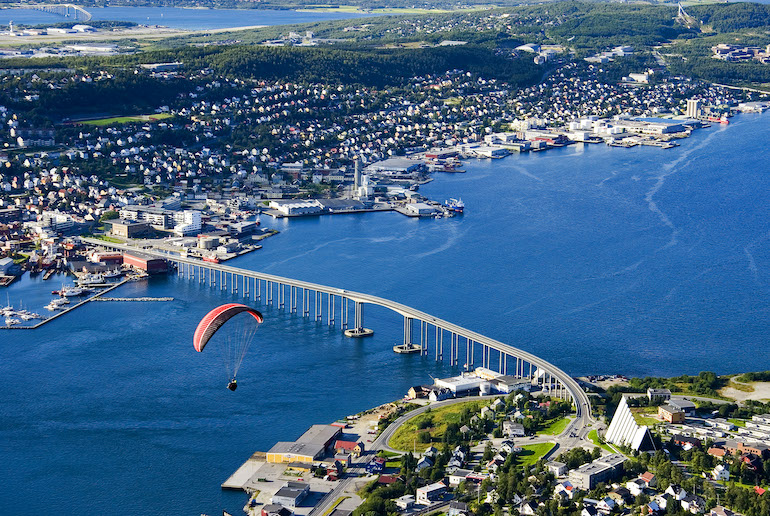
Tromsø is the largest Norwegian city in the Arctic Circle / Fjellheisen (CC)
What is the largest city north of the Arctic Circle?
Most of the large cities above the Arctic Circle are in Russia, with Murmansk being the biggest. So, here are the top ten most populated cities in the Arctic Circle, with their populations.
| Arctic city | Population |
| Murmansk, Russia | 290,000 |
| Norilsk, Russia | 180,000 |
| Tromsø, Norway | 75,000 |
| Vorkuta, Russia | 60,000 |
| Apatity, Russia | 50,000 |
| Severomorsk, Russia | 50,000 |
| Bodø, Norway | 42,000 |
| Monchegorsk, Russia | 40,000 |
| Kandalaksha, Russia | 35,000 |
| Kirovsk, Russia | 26,000 |
Which cities does the Arctic Circle pass through?
We’ve learnt above that the northern polar circle runs through eight separate countries, four of which are in Scandinavia.
And if you count Greenland as a part of Denmark (see our post for more on this thorny issue), it runs through all five of the Nordic nations. But which cities does this imagery line run through or near to?
Where is Arctic Circle in Finland?
With a population of 63,000, Rovaniemi is the largest settlement in Finland that lies close to the Arctic Circle.
The city centre is actually about 5 miles south of the northern polar line, but its suburbs stretch out towards the Santa Claus Village, which is built on the actual line itself.
The line is marked here, and you can even get a certificate to prove you’ve crossed it!
The Arctic Circle also runs through a few smaller settlements in Finland including Juoksenki close to the Swedish border and Suomu in the east.
Where is Arctic Circle in Sweden?
The largest settlement in Sweden that’s close to the Polar Circle is Jokkmokk, hub of the Sami people in Swedish Lapland, and home to the 400-year-old annual Sami winter market.
The town lies about 7 miles north of the actual polar line, which is marked by a big road sign.
Other smaller villages in Sweden that are on the Arctic Circle include Juoksengi, on the Finnish border in the far east, Överkalix and Murjek.
For more on crossing the polar circle in Sweden, see our guide.
Where is the Arctic Circle in Norway?
Almost half of Norway is in the Arctic, with Mo-i-Rana being the largest settlement close to the Arctic line.
However, the town lies about 50 miles southwest of the actual polar line itself, which is at Saltfjellet near the Swedish border and marked by a steel globe known as the Arctic Circle Monument.
Where is the Arctic Circle in Iceland?
Although it is considered one of the Arctic countries, the mainland of Iceland actually lies just south of the polar circle.
Perhaps surprisingly, the only part of Iceland that is north of the Arctic Circle is the small island of Grímsey, off Iceland’s north coast.
In fact, the Arctic Circle crosses Grímsey, so not even all the island (which is only three miles long) lies within the Arctic!
And the only settlement on Grímsey, Sandvik, has a population of less than 100 people, so there really aren’t any Icelandic cities on the Arctic Circle.
Where is the Arctic Circle in Denmark?
Although mainland Denmark lies way south of the Arctic Circle, the majority of the island of Greenland lies within the Arctic.
Greenland is an autonomous country that is part of the Realm of Denmark, and two thirds of it landmass lies above the northern polar line.
There are few towns in Greenland, and even its capital Nuuk has a population of less than 20,000.
Greenland’s second largest town, Sisimiut and the village of Kangerlussuaq are the nearest settlements in Greenland to the Arctic Circle.
Can you live above the Arctic Circle?
Yes, it is possible to live within the northern polar circle, and around four million people do so. The majority of them (more than 60 percent) live in Russia, while around ten percent of the inhabitants of the Arctic are indigenous people.
Will more people move to the Arctic Circle?
Despite a huge increase being predicted in the global population, studies suggest that the population of the Arctic will rise by only around one percent by 2050.
This is because mass global migration tends to be to cities rather than the countryside and there are very few cities in the Arctic.
Interestingly, the Russian Arctic cities are projected to see a decrease in population, while Iceland (a politically stable, affluent country) is expected to see an increase.
What is it like to live above the Arctic Circle?
Clearly, living in the Arctic means dealing with sub-zero temperatures, long nights in winter, long days in summer and a harsh climate. And the area around the North Pole is currently covered with sea ice year-round.
With vast swathes of wilderness, much of which is unpopulated, the Arctic has little transport infrastructure so travelling between the cities is difficult.
However, the effects of global warming mean that by 2050, the Arctic may be ice-free in the summer, with drastic consequences for the wildlife, eco-systems and human life.
Which animals live in the Arctic Circle?
Unsurprisingly, animals that thrive in cold conditions live within the northern polar circle.
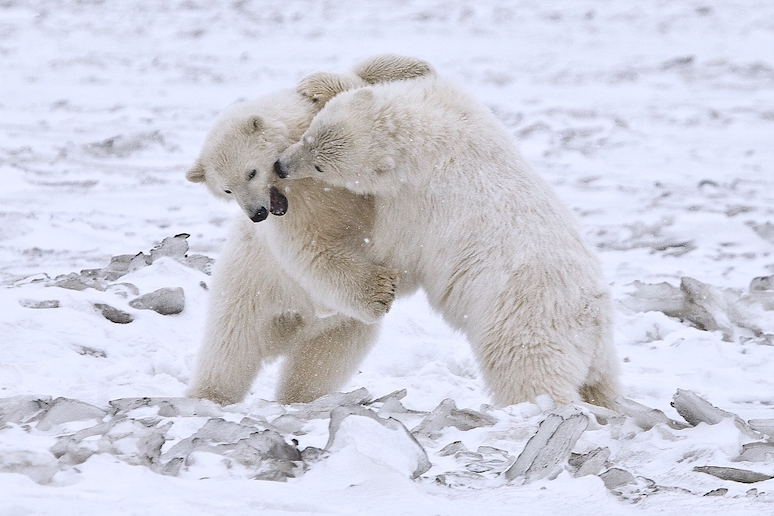
These include polar bears, brown bears, walruses, Arctic foxes, Arctic hares, Arctic wolves, several species of whale and dolphin, moose, reindeer (or caribou), musk oxen, several species of seal, puffins, snowy owls and sea otters – amongst others.
Sadly, populations of many of these animals are in decline due partly to climate change, with animals such as polar bears, walruses and musk oxen being particularly vulnerable.
FAQs about the Arctic Circle
Is Sweden in the Arctic Circle?
Only 15 percent of Sweden is north of the Arctic Circle, with the majority of the country lying to the south.
Which Asian country has land within the Arctic Circle?
The only Asian country that has land within the Arctic Circle is Russia. Of course, about a quarter of Russia is in Europe, but three quarters of this huge country is in Asia.
Can you see Arctic Circle?
No, you can’t actually see the Arctic Circle as it’s an imaginary geographical line that is marked on a map, like the equator and the tropics of Cancer and Capricorn.
However, there are places where signs have been erected to mark where the Arctic Circle is.
Can you drive to the Arctic Circle?
Yes, you can drive to settlements such as the Santa Claus Village in Rovaniemi in Finland, and Saltfjellet in Norway.
These both mark the location of the Arctic Circle in a big way, and there are also points where the road crosses the polar line which are marked by a simple sign.
However, the majority of the polar line passes through inaccessible wilderness and is unmarked.
Which island country is near the Arctic Circle?
As we’ve seen above, a very tiny part of the island of Iceland lies within the Arctic Circle, but there’s a much larger island with the majority of its landmass above the Arctic Circle – and that’s Greenland.
Around two-thirds of this huge island lie within the Arctic Circle.
What state does the Arctic Circle pass through?
The only US state that has land within the northern polar circle is Alaska.
What continents does the Arctic Circle run through?
The Arctic Circle runs through three continents: America (the US and Canada), Europe (the Scandinavian countries) and Asia (Russia).
Does the Arctic Circle cross the Southern Ocean?
No, it’s the Antarctic Circle that crosses the Southern Ocean. The Arctic Circle more or less surrounds the Arctic Ocean, the world’s smallest and shallowest ocean.
It also crosses smaller seas, including the Barents Sea, the Norwegian Sea and the Bering Sea.
See also:
Crossing the Arctic Circle in Swedish Lapland
Where to see the midnight sun in Norway
Seeing the northern lights in Scandinavia

